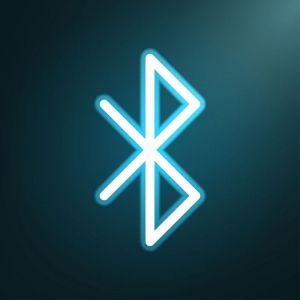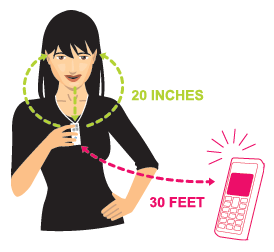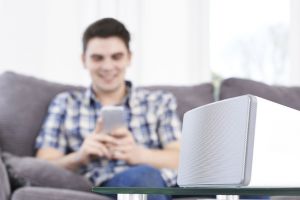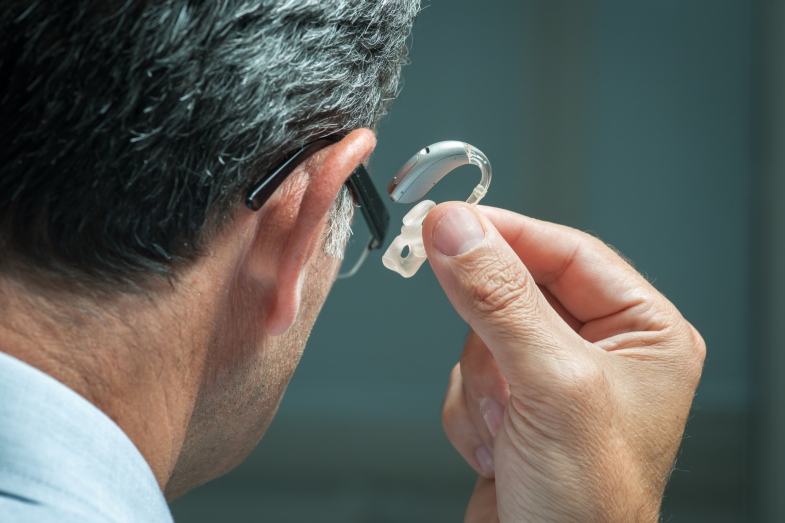Hearing aids of the past often limited the wearer’s access to many personal audio devices such as mobile phones and music players. For example, to use a music player while jogging, you would have had to remove your hearing aids to accommodate a pair of earbuds. However, today’s sophisticated wireless hearing aids, such as the Oticon MoreTM, use Bluetooth technology to make it possible to connect with personal electronic devices and stream sound directly to hearing aids.
Table of Contents
Bluetooth and hearing aids

secure wireless platform.
Developed through a collaboration of leading technology firms, Bluetooth is a wireless communication platform that allows for the transfer of data between two or more electronic devices. The technology uses radio waves set to a high frequency to transmit data without interference or security risks. A wide variety of products incorporating Bluetooth connectivity have been developed, including mobile phones, music players, computers, tablets and televisions.
Made for iPhone
Apple has patented specific Bluetooth connectivity with hearing aids so that certain hearing aids can communicate directly with the iOS platform that runs iPhone, iPad and iPod Touch devices. This technology is designed to allow the devices direct connection without extreme stress on battery power. Most hearing aid manufacturers have released hearing aids that implement this Bluetooth technology, marketed as Made for iPhone™. Visit Apple’s website for a current listing of specific hearing aids that are compatible with the iOS platform.
Android phones
Google is currently developing a similar hearing aid compatibility standard for the Android platform, and several hearing aid brands can now stream to Android-based phones using version 10.0 or higher.
What if my hearing aids can’t connect?

to your hearing aids.
If your hearing aid doesn’t include a feature for direct streaming from your smartphone to your hearing aids, don’t worry. Manufacturers of wireless hearing aids long ago created a clever solution for accessing this prevalent wireless standard. Wireless hearing aids can use compatible assistive listening devices, often called streamers, to provide a communication link between the wireless technology in the hearing aids and any Bluetooth-enabled device.
The wireless hearing aids can be paired with the streamer, and then the streamer can be paired with external devices. When it’s all set up, the streamer will pick up the Bluetooth signal from your phone, for example, and send it to your hearing aid via an FM signal or electromagnetic field, depending on the manufacturer’s design. Usually, the streamer is worn around the neck or placed in a pocket for hands-free operation. Speak to your hearing care provider about the best streamer option for you.
What are the benefits of streaming via Bluetooth?
Whether you direct stream to your iPhone or you use an additional device to access your mobile phone or music player, a streamer provides many opportunities that were previously unavailable.
Personalized listening experience
The audio signal can usually be set to stream to one or both hearing aids and the streamed signal can be amplified and customized to match the aid’s settings, such as for music listening. The volume of the stream may be controlled by the streamer or the hearing aids, depending on the manufacturer’s design. For music, your hearing aids can become a set of wireless earbuds. For an iOS or Android phone, you may want to stream the signal to just one hearing aid so as to keep the other one for other sounds in the room. This hands-free solution sure beats trying to position the mobile phone receiver close to the hearing aid microphone!
Multiple connections

to the rest of your technology world.
Multiple devices can usually be paired to one streamer, so you can easily switch between different devices. For example, you can be connected to your mobile phone while you’re streaming a movie from your tablet. The streamer is able to interrupt or pause the audio from your tablet in order to bring you the audio signal from an incoming phone call.
Remote control of your hearing aids
Commonly, there are also capabilities for remotely changing the volume or program from the streamer. This is especially useful if your hearing aids are too small to accommodate external controls.
Standard protocol
Last but not least, Bluetooth is an electronics industry standard protocol. It’s not unique to a particular hearing aid or hearing aid manufacturer, so there is uniformity in the way that it works across all devices. The platform has been tested and refined already, as it’s been in use for many years in the mobile phone industry. As stated above, the Bluetooth connection is secure and there’s no interference.
Bluetooth is today’s cutting edge technology
Bluetooth technology in hearing aids has greatly elevated the hearing aid wearing experience and enable hearing aids to double as highly-personalized, custom audio devices. It’s an example of using today’s wireless hearing aid technology in a smart way that truly provides convenience for hearing aid wearers.
To use your hearing aids to stay connected to your network of friends and family and all of your latest audio devices, talk to your hearing care professional about wireless hearing aids, Bluetooth streaming and Made for iPhone™ hearing aids. Want to upgrade? Use our directory to find hearing aids near you.


